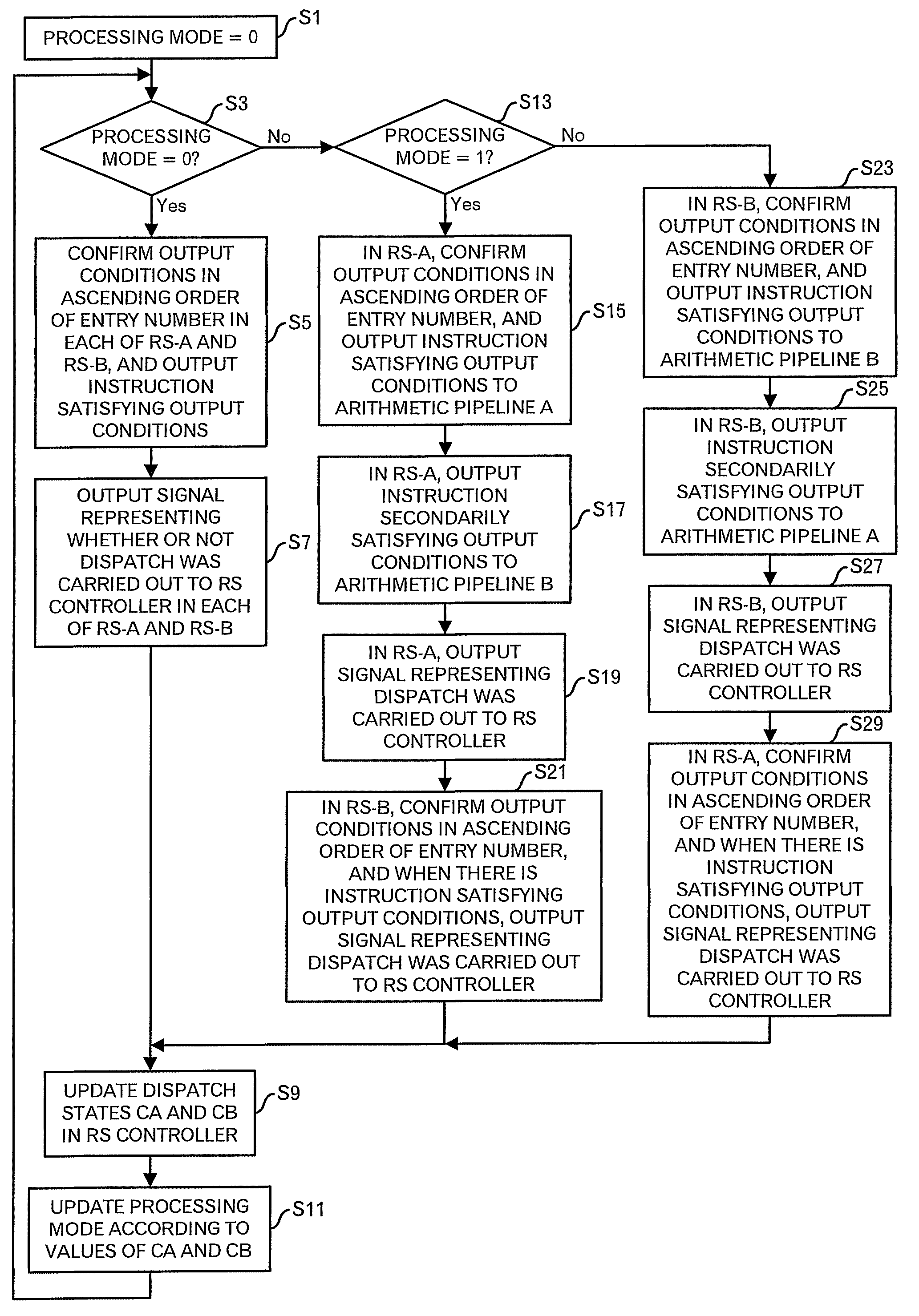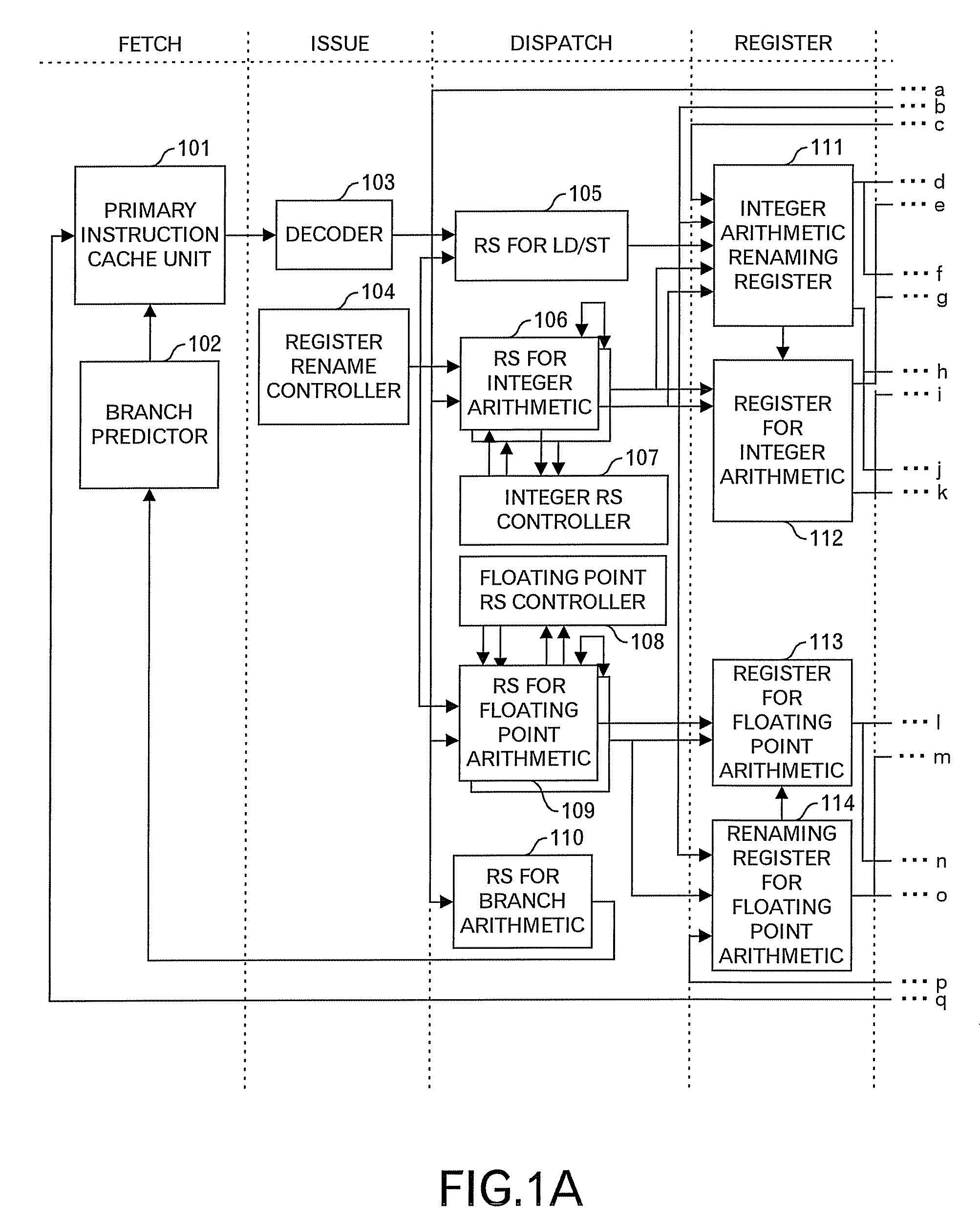Processor device for out-of-order processing having reservation stations utilizing multiplexed arithmetic pipelines
a processor device and reservation station technology, applied in the direction of program control, computation using denominational number representation, instruments, etc., can solve the problems of narrow instruction choice range, increase the number of stages in the arithmetic pipeline, complicated logic implementation to select plural instructions to be issued from a lot of entries, etc., to achieve efficient utilization of multiplexed arithmetic pipelines and increase the complexity of instruction issuance logi
- Summary
- Abstract
- Description
- Claims
- Application Information
AI Technical Summary
Benefits of technology
Problems solved by technology
Method used
Image
Examples
embodiment 1
[0055]FIG. 2 shows an outline diagram in the first embodiment. In FIG. 2, a first reservation station RS-A and a second reservation station RS-B are provided, and the first reservation station RS-A is associated with an arithmetic pipeline A in principle, and the second reservation station RS-B is associated with an arithmetic pipeline B in principle. Thus, when one-to-one association is made between the reservation station and the arithmetic pipeline, there is a merit that a processing to judge which instruction among the instructions held in the reservation stations should be outputted to the arithmetic pipeline becomes simple. On the other hand, when there is no instruction dispatchable in the reservation station, because any instruction cannot be dispatched to the arithmetic pipeline, bubbles occurs in the arithmetic pipeline, and accordingly the execution efficiency is lowered. Then, as shown in FIG. 2, for example, one set is composed of the first reservation station RS-A and ...
embodiment 2
[0067]FIG. 5 indicates an outline diagram in the second embodiment. In FIG. 5, a first reservation station RS-A and a second reservation station RS-B are provided, and the first reservation station RS-A is associated with an arithmetic pipeline A, and a second reservation station RS-B is associated with an arithmetic pipeline B. Therefore, when there is no dispatchable instruction in the reservation station, because any instruction cannot be dispatched to the arithmetic pipeline, there is a problem that bubbles occurs in the arithmetic pipeline, and the execution efficiency is lowered. Then, as shown in FIG. 5, for example, one set is composed of the first reservation station RS-A and the second reservation station RS-B, and when there is no dispatchable instruction in the second reservation station RS-B, the first reservation station RS-A selects instructions of the predetermined number, and moves such instructions to the second reservation station RS-B as indicated by an arrow in ...
embodiment 3
[0086]FIGS. 9A and 9B show an outline diagram of a third embodiment of this invention. In this embodiment, a case that only one reservation station is provided, different from the first and second embodiments, is handled, that is, an intensive type reservation station is handled. In an example of FIG. 9A, the reservation station includes 16 entries RS0 to RS15. Then, in a normal mode that instructions are stored in almost all entries of the reservation station, the entries RS0 to RS3 are associated with an arithmetic pipeline A, the entries RS4 to RS7 are associated with an arithmetic pipeline B, the entries RS8 to RS11 are associated with an arithmetic pipeline C, the entries RS12 to RS15 are associated with an arithmetic pipeline D, and logical groups whose number is the same as the number of arithmetic pipelines are defined. In the reservation station, the priority is set to each entry, and in FIGS. 9A and 9B, it is assumed that the entry having the highest priority is the entry ...
PUM
 Login to View More
Login to View More Abstract
Description
Claims
Application Information
 Login to View More
Login to View More - R&D
- Intellectual Property
- Life Sciences
- Materials
- Tech Scout
- Unparalleled Data Quality
- Higher Quality Content
- 60% Fewer Hallucinations
Browse by: Latest US Patents, China's latest patents, Technical Efficacy Thesaurus, Application Domain, Technology Topic, Popular Technical Reports.
© 2025 PatSnap. All rights reserved.Legal|Privacy policy|Modern Slavery Act Transparency Statement|Sitemap|About US| Contact US: help@patsnap.com



